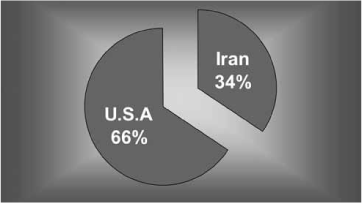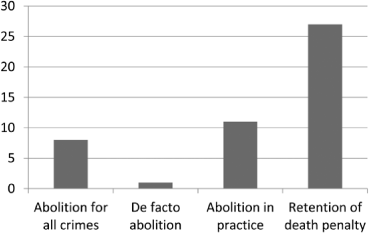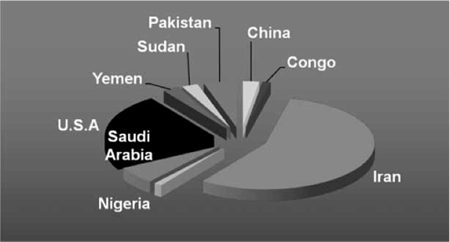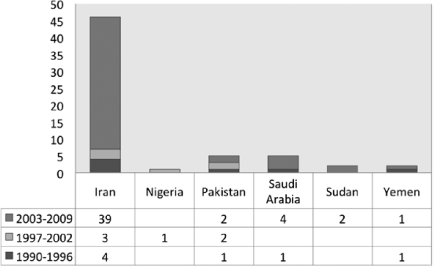Juvenile Death Penalty in Islamic Countries: The Road to Abolition is Paved with Paradox

Chapter 2
Juvenile Death Penalty in Islamic Countries: The Road to Abolition is Paved with Paradox
Sanaz Alasti
Avoid [sentences of] death and flogging involving Muslims to the extent possible.1
Ibn Abi Shayba2
Maturity is an important factor in evaluating whether a sentence of death is an appropriate response to juvenile crime.3 The juvenile justice system itself was formed on the principle that the relative immaturity of children warrants separate treatment from adults. Whether juvenile offender sentences are appropriate depends in part on whether the juvenile is sufficiently responsible to deserve it. In the case of the death penalty, maturity is central to whether a punishment is consistent with societal norms, and whether it is proportionate to the harm caused.
A juvenile offender may have known right from wrong enough to be considered guilty of the crime, but such a determination does not mean that the juvenile offender is sufficiently culpable and incorrigible to warrant the death penalty. Unfortunately, many juvenile offenders do not receive an individualized consideration of their maturity, only their guilt. The transfer to adult court that makes the death penalty available is often based on the severity of the crime, not the mental state of the offender. Treating a juvenile like an adult simply based on the type of offence may be regarded as illogical because juvenile offenders have troubled childhoods, and capital punishment for juvenile offenders is a solution that fails to adhere to international law.
The aim of this chapter is to provide the background of the evolution of the juvenile death penalty policy and an empirical profile of executing children in the political and Islamic criminal justice systems. It develops an analysis of the factors that may influence the future of capital punishment as a criminal sanction for children in Islamic nations.
Figure 2.1 Status of the death penalty in 47 Islamic jurisdictions as of March 2010
Source: Amnesty International.
Notes: Abolition for all crimes: Albania (2007), Azerbaijan (1998), Djibouti (1995), Kyrgyzstan (2007), Senegal (2004), Turkey (2004), Turkmenistan (1999), Uzbekistan (2008). De Facto abolition: Kazakhstan (2007). Abolition in practice: Algeria, Brunei, Burkina Faso, Gambia, Maldives, Mali, Mauritania, Morocco, Niger, Tajikistan, Tunisia. Retention: Afghanistan, Bahrain, Bangladesh, Chad, Comoros, Egypt, Guinea, Indonesia, Iran, Iraq, Jordan, Kuwait, Lebanon, Libya, Malaysia, Nigeria, Oman, Pakistan, Qatar, Saudi Arabia, Sierra Leone, Somalia, Sudan, Syria, United Arab Emirates, Yemen.
Eighteen years is the internationally accepted minimum age for the imposition of capital punishment. According to Amnesty International, since 1990 only nine countries in the world are known to have executed juvenile offenders: China, Nigeria, Congo, Pakistan, Iran, Saudi Arabia, Yemen, Sudan and the United States. Of those nine countries, five are Muslim.4
More than two-thirds of the countries in the world have now abolished the death penalty in law or practice. Of 58 retentionist countries, 26 of them are Islamic countries. In 11 Islamic countries, abolition is in practice.5 In eight countries, Islamic laws do not provide for the death penalty for any crime (abolitionists for all crimes), and in one Islamic country, laws provide for the death penalty only for exceptional crimes such as crimes under military law or crimes committed in exceptional circumstances (de facto abolition) (see Figure 2.1).
Over the last decade, the issue of the juvenile death penalty has received significant public attention. Almost all nations, even those with a death penalty, believe it is inherently cruel, and they have agreed to put aside the death penalty for juvenile offenders. In the United States, although American public opinion favours retaining the death penalty in general, it opposes executing offenders under the age of 18. In addition, a long list of international agreements and protocols has prohibited the juvenile death penalty.
Between 1990 and 2009, at least 82 executions of juvenile offenders have been carried out around in the world: China (2), Democratic Republic of Congo (1), Iran (46), Nigeria (1), Pakistan (4), Saudi Arabia (5) Yemen (2), Sudan (2) and the USA (19) (see Figure 2.2).
Figure 2.2 Juvenile executions in the world since 1990
Source: Amnesty International, Executions of Juveniles since 1990, http://amnesty.org/en/death-penalty/executions-of-child-offenders-since-1990 (accessed 30 May 2013).
Although the number of juvenile offenders affected by the death penalty is small, it is in direct conflict with international law, violates the right to life and is the ultimate cruel, inhuman and degrading punishment. The execution of juvenile offenders continues in two Islamic countries: Iran and Saudi Arabia. Juvenile offenders remain on death row in several other Islamic countries around the world. Pakistan,6 China7 and Congo8 have abolished the juvenile death penalty. The USA has recently abolished the juvenile death penalty, and in Iran a bill to raise the minimum age to 18 is under consideration. Ayatollah Mahmoud Hashemi-Shahrudi, the head of Iran’s judiciary, sent a directive to judges instructing them to stop issuing death verdicts for juveniles.
The Story of the Juvenile Death Penalty in Islamic Countries
Why do a handful of states still execute juvenile offenders when the rest of the world has moved towards abolition of the juvenile death penalty? After the adoption of the Convention on the Rights of the Child, there were about 11 states in the world, most of them Arab or Islamic, that retained the death penalty for juvenile offenders. One by one, they eliminated the practice. Some of them claimed this might conflict with Sharia law, but they did it anyway in order to conform with their international obligations.9
We know of only two countries with a broadly threatened and applied juvenile death penalty since 2009 – Iran and Saudi Arabia – but between 1990 and 2009 at least 60 executions against juvenile offenders have been carried out in Islamic countries. As noted earlier, these include Iran (46), Nigeria (1), Pakistan (4), Saudi Arabia (5) Yemen (2) and Sudan (2).
Saudi Arabia
Saudi Arabia10 has one of the highest rates of execution in the world. Since 1990, Saudi Arabia has executed five persons under 18, and juvenile execution is problematic in this country. Saudi Arabia has neither a codified penal law establishing the acts that constitute criminal offences nor a published official interpretation of Sharia law, which constitutes the basis for all laws in the Kingdom. Instead, judges have broad discretion to interpret and apply Sharia precepts in criminal cases.11
Saudi Arabia became a party to the Convention on the Rights of the Child in 1996. In its initial report to the UN Committee on the Rights of the Child on the measures taken to give effect to the rights recognized in the Convention, the Saudi Arabian government stated that ‘capital punishment cannot be imposed on children who have not attained the age of majority in accordance with Islamic law’.12
In Saudi Arabia, children who have reached puberty may face the death penalty for a variety of crimes, including adultery, apostasy, corruption on earth,13 drug trafficking, sabotage,14 political rebellion and murder during armed robbery, as well as for actions within the broad category allowing courts’ discretionary punishment.15
On 24 November 2008, the Shura Council16 passed a measure to raise the general age of majority from 15 to 18, despite the opposition of the Council’s Islamic Affairs, Judiciary and Human Rights Committee. On 4 October 2010, the Council again debated the age of majority in the context of a draft law on protecting children from violence and neglect. The Saudi Cabinet has passed neither measure into law, and their applicability to capital punishment remains unclear.17 Saudi Arabia has set but does not effectively enforce 12 years as the minimum age of criminal responsibility for boys. Majority is attained when any one of four conditions are met: reaching 15 years of age, the occurrence of nocturnal emissions (‘wet dreams’), the appearance of pubic hair and, in the case of girls, upon menstruation.18
Trial judges make decisions on whether a defendant is a child based on physical signs of puberty at the time of trial, and not at the time of the crime. Children have been tried as adults and sentenced to death for crimes committed at age 13.19
Saudi Arabia is a state party to both the International Covenant on Political and Civil Rights and the Convention of the Rights of the Child. Nevertheless, it is among the few countries to have executed juvenile offenders in recent years. According to Amnesty International, 126 juvenile offenders have been sentenced to death in Saudi Arabia.
Sudan
A range of Islamic laws was promulgated in the 1980s and early 1990s for all of Sudan, and the Islamic Penal Code of 22 March 1991 replaced the 1983 Code. Article 8 of the Sudan Criminal Act (1991) provides: ‘There shall be no responsibility except upon a mature person of free will.’20 Also, Article 9 states: ‘A child who has not attained puberty shall not be deemed to have committed an offense; provided that care and reform measures set out in this Act may be applied to a child who has completed seven years of age, as the court may deem fit.’21
Finally, Sudan amended its laws in January 2010 to set 18 years as the firm age of majority nationwide. Also, a January 2010 amendment to the Child Act set 18 years as the firm age of majority. Previously, Sudan’s legal system contained ambiguous provisions allowing an individual to reach the age of majority as young as 15. In December 2008, a Sudan Supreme Court decision confirmed the death sentence for Abdulrahaman Zakaria Mohammed, a juvenile offender executed in 2009. This decision was based in part on a conclusion that the prohibition of capital punishment for juveniles did not extend to hudud22 offences. It is not clear whether the new 2010 law would affect the court’s ruling regarding future hudud cases. Also, under certain circumstances, Article 27(2)23 of the Criminal Code allows capital punishment for children aged 7–18 sentenced to hadd offences or murder (qisas).24
The Supreme Court in Khartoum confirmed the death sentence in December 2008 based on two arguments. First, it found that the prohibition of the death penalty for children did not extend to hudud offences. Second, the court found that the definition of a child should be drawn from the definition of ‘adult’ provided in the Criminal Act, which was that ‘adult means any person whose puberty has been established by definite natural features and who has completed 15 years of age, and whoever attains 18 years of age shall be deemed an adult even if the features of puberty do not appear’.25
Although the new Criminal Code of Sudan states that the death penalty shall not be imposed on a person under the age of 18 or a person who has attained the age of 70 except in cases of hudud and qisas, it is the case, as in some other Muslim countries, that a minor accused of murder, rape or adultery can be sentenced to death.
Yemen
In Yemen, since the 1991–94 unification, the government appears to be moving towards consolidating the Sharia with inherited common law, with some basic laws amended, but eventually the People’s Republic’s criminal, criminal procedure and evidence laws have been replaced by Sharia-inspired unified legislation. In 1994, the minimum age for the use of the death penalty in Yemen was raised to 18 years at the time of the offence in the Penal Code (Article 31 of Law 12). In the 1990s, Yemen was one of the few countries to execute juvenile offenders.26 Nevertheless, in 1991 Yemen signed the UN Convention on the Rights of the Child. In 1994, Yemen amended its Penal Code to raise to the legal age to incur a death sentence to 18. However, because of the lack of official birth certificates, the calculation of the age is often made according to physical characteristics. Numerous minors are thus sentenced to death.27
Pakistan
The Pakistan Penal Code of 1860, the Code of Criminal Procedure of 1898 and other statues awarding punishments for crimes apply in all four provinces of Pakistan, except in the designated tribal areas. The Pakistan Penal Code provides that ‘nothing is an offence which is done by a child under seven years of age’28 and ‘nothing is an offence which is done by a child above seven years of age and under twelve who has not attained sufficient maturity of understanding to judge of the nature and consequence of his conduct on that occasion’.29 However, no guidelines are provided for a judge to establish maturity; a child’s right to be treated as a child depends on the subjective leniency of a judge.
The Pakistan Penal Code and Code of Criminal Procedure do not establish an age limit below which the death penalty may not be imposed. However, under the qisas and diyat law30 (which prescribes restitution or compensation for the victim), the sentence for murder may not be imposed on anyone below the age of 18 at the time of the offence. The hudud laws of 1979, which replace corresponding sections of the Pakistan Penal Code, apply to all parts of Pakistan and override all other legislation. The hadd punishment may not be imposed on children, but the definition of a child in the hudud laws differs from that of other laws in Pakistan. Based on hudud laws, a child is a person who has not attained puberty. Therefore, a girl of 12 years old who has attained puberty is legally adult and could be sentenced to the hadd punishment.31 Since promulgation of the hudud laws in Pakistan, the percentage of girls accused of adultery has increased greatly. UNICEF has cited some cases of even 12- and 13-year-old girls being punished for adultery.32
Amnesty International recorded four executions of child offenders in Pakistan in the 1990s. The Sindh Children’s Act (1955), which only came into force in 1974, states in Section 68 that a youthful offender, defined as a person below 16 years of age at the time of initiation of proceedings, may not be sentenced to death, transportation or imprisonment. The Punjab Youthful Offenders Ordinance (1983), which was brought into operation only in the district of Sahiwal in 1993 but not in other parts of Punjab, bans the death penalty and life imprisonment for any offender below the age of 15 at the time of the offence; there are no special laws protecting juveniles in Balochistan and the North West Frontiers Province, nor in the tribal areas.
The Juvenile Justice System Ordinance (2000), abolishing the death penalty for people under 18 at the time of the offence in most parts of the country, entered into force on 1 July 2000. However, the Ordinance was not extended to the provincially and federally administered tribal areas in the north and west. Also, the Ordinance neither made reference to some fifty people then under sentence of death who were below the age of 18 at the time of the offence, nor did it provide for a review of such cases.
On 3 November 2001, Sher Ali was hanged in Timergarah; he had been sentenced to death for a murder committed in 1993 when he was 13 years old. The Supreme Court had earlier rejected an appeal which argued that in 1993 the death penalty could not be imposed in the provincially administered tribal areas where he had lived.33 Some juveniles were tried and sentenced to death by special military courts in Pakistan. Special military courts were established in Sindh Province to ensure speedy trials of civilians charged with serious criminal offences.34
Although most of the outstanding death sentences imposed on child offenders before July 2000 have now been commuted, an unknown number of sentences are still outstanding while the courts determine the age of the convicted prisoners. Child offenders continue to be sentenced to death, mainly because their age has not been determined. The issue of age is generally not raised by the family’s legal counsel until a child has been sentenced to death. Often judges do not raise the issue of age unless the child looks like a minor.
Figure 2.3 Juvenile execution rates in six Islamic countries since 1990
Source: Amnesty International.
Nigeria
Among many conflicting statements, Nigeria defines the age of adulthood nationally as 17,35 and 12 states in northern Nigeria operate under Sharia laws, some of which define the age of legal responsibility as younger than 17 and assign criminal responsibility upon puberty, without regard to age per se, for hudud capital crimes such as adultery, rape, sodomy and incest. Article 18 of Criminal Code Act of Nigeria provides:
Whenever a male person who in the opinion of the court has not attained 17 years of age has been found guilty of any offense the court may, in its discretion, order him to be caned in addition to or in substitution for any other punishments to which he is liable.
Under Nigerian law, there are three stages for childhood: (1) a person under the age of seven years is not criminally responsible for any act or omission; (2) a person under the age of 12 years is not criminally responsible for an act or omission, unless it is proved that at the time of committing the act or making the omission the person had the capacity to know that they ought not to do the act or make the omission; (3) a male person under the age of 12 years is presumed to be incapable of having carnal knowledge.
In Nigeria, over thirty juvenile offenders were on death row as of March 2010, even though Nigeria is not known to have executed a juvenile offender since 1997.36
Iran
The criminal responsibility age was 18 under the former Penal Code of Iran. Juvenile execution is a product of the Islamic Revolution of 1979. The establishment of the Iranian juvenile court dates back to 1959. In 1982, following the ratification of Islamic Penal Code, the modern Penal Code of Iran was regulated in accordance with novel concepts of crime, and punishment was abolished. The present criminal justice system in Iran is based on the Twelve Imami Shii version of Sharia law. This system of law was formed in the early 1980s during the tenure of Ayatollah Ruhullah Musavi Khomeini. Islamic law replaced the secular system that two Pahlavi monarchs established in Iran during their consecutive reigns.
The Iranian Civil Code states: ‘In Iranian law childhood is attributed to a person who has not reached puberty age.’ Under Article 1210-1: ‘A girl achieves puberty after nine lunar ages and a boy after completing fifteen lunar years.’37
Iranian penal law applies to those who have reached puberty (age 9 years for girls and 15 years for boys).38 For example, under Iranian law if a 10-year-old girl commits murder, she will be tried and punished in the same way as a 40-year-old woman. Thus, under the Islamic Penal Code of Iran it is permissible to issue a death sentence for a female juvenile who has reached 9 years of age. In practice, no child has been sentenced to death under the age of 13, but the law remains on the statute book and can be imposed.
Despite this statute, according to the directive issued by Ayatollah Mahmoud Hashemi-Shahrudi, the head of Iran’s judiciary, judges cannot issue death sentences for juveniles. A bill to raise the minimum age to 18 is now under consideration in Iran. If trial court judges consider the current statute, it will be reversed in the Supreme Court. All death sentences must be upheld by the Iranian Supreme Court before they can be implemented. Articles 33 and 35 of the draft law39 specify the different punishments that can be imposed on juveniles. They both state that in cases of juveniles aged 15–18, crimes punishable by death or life imprisonment for adults will be replaced by two to eight years of detention at a correctional centre.
The patterns in most Islamic nations over the last two decades are consistent with the longer-term declines in the prevalence of juvenile executions (see Table 2.1


